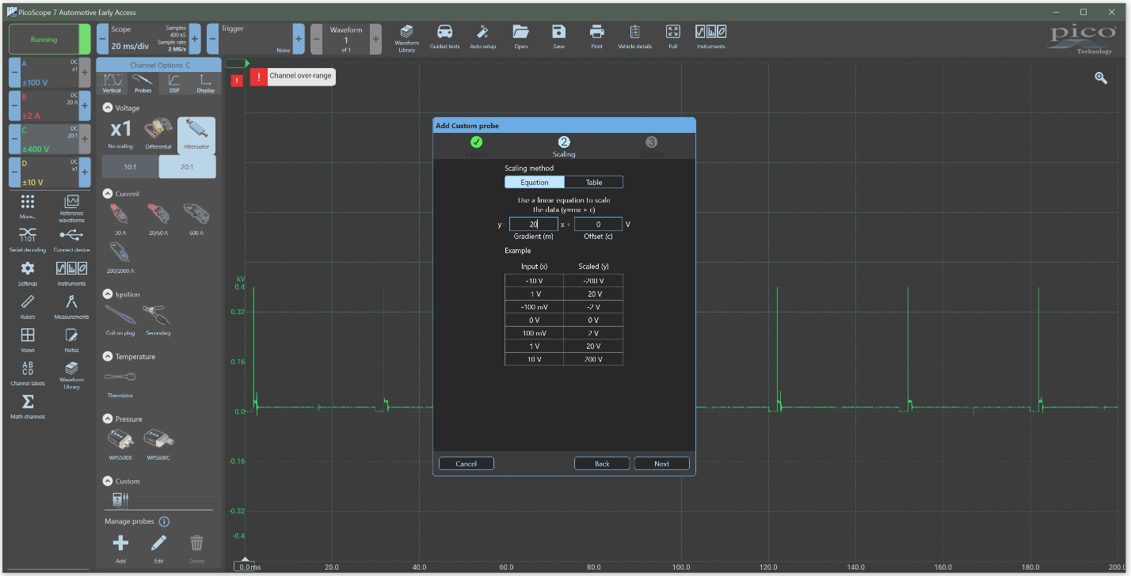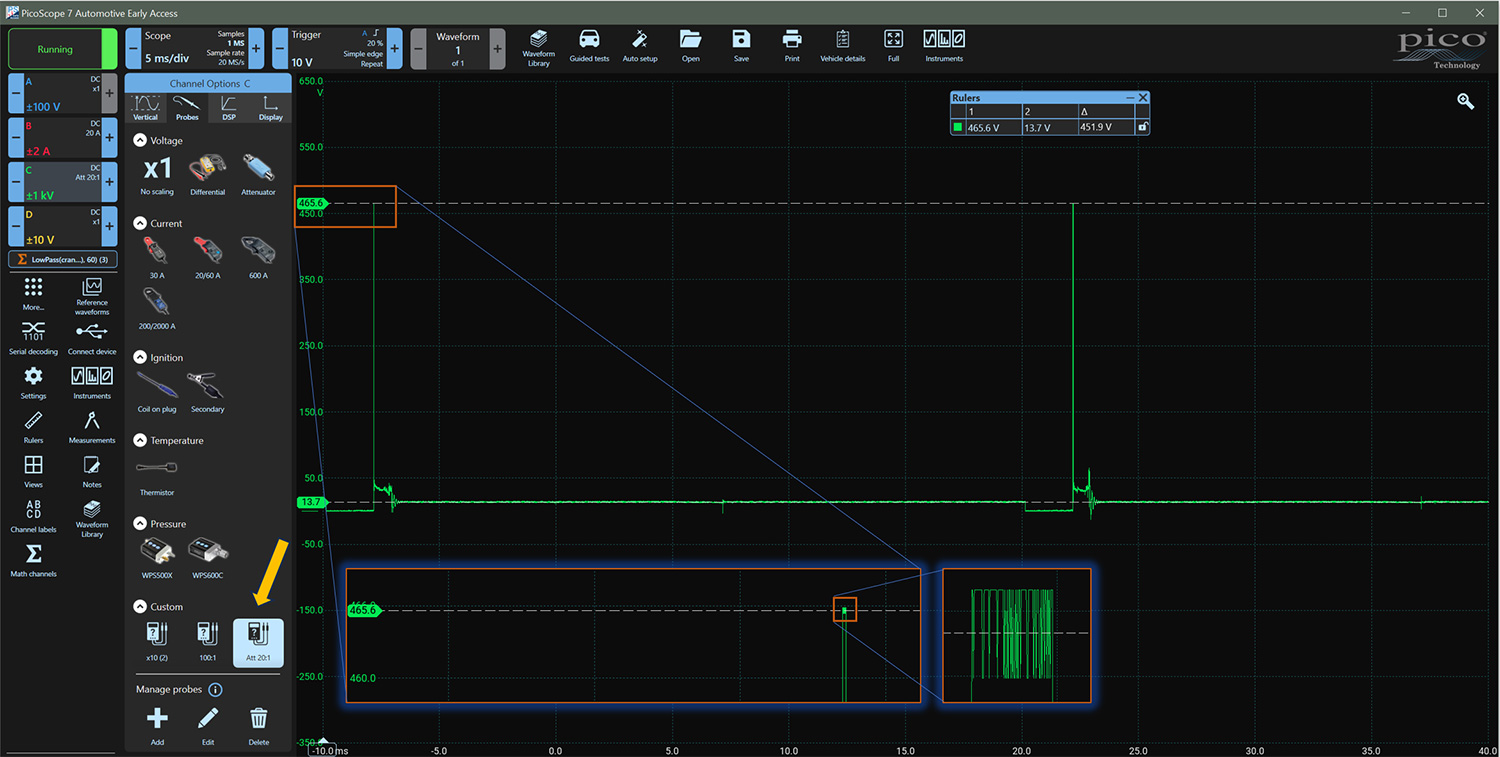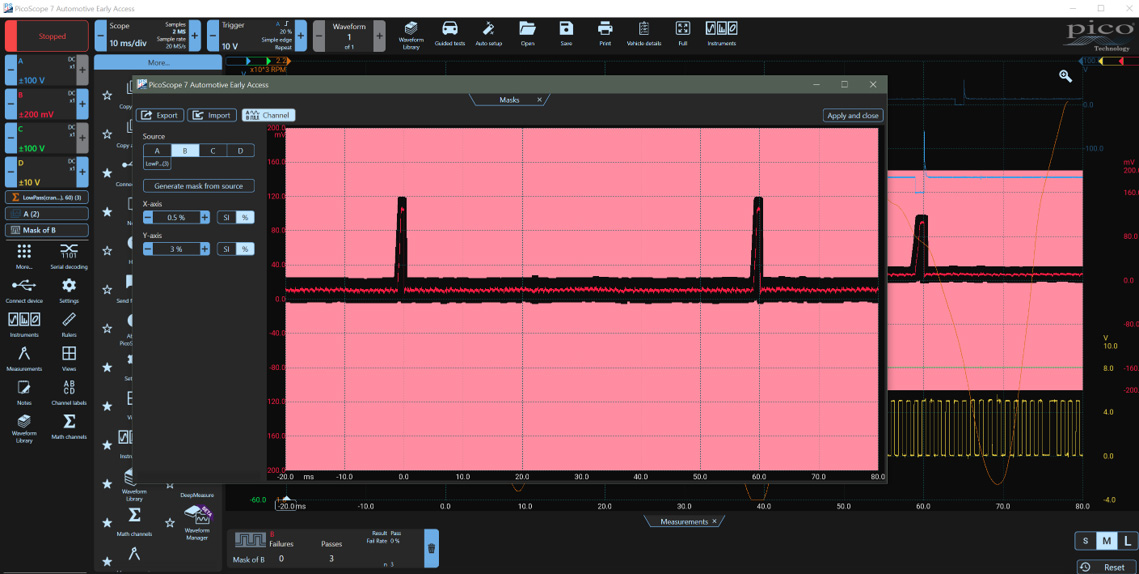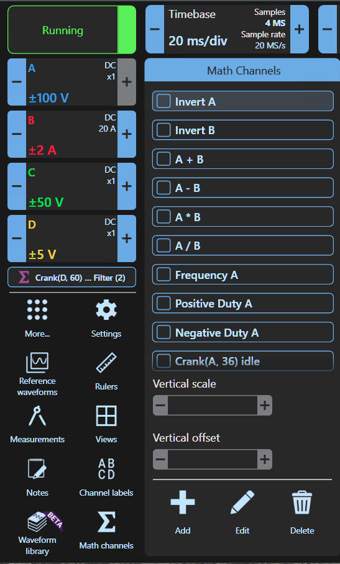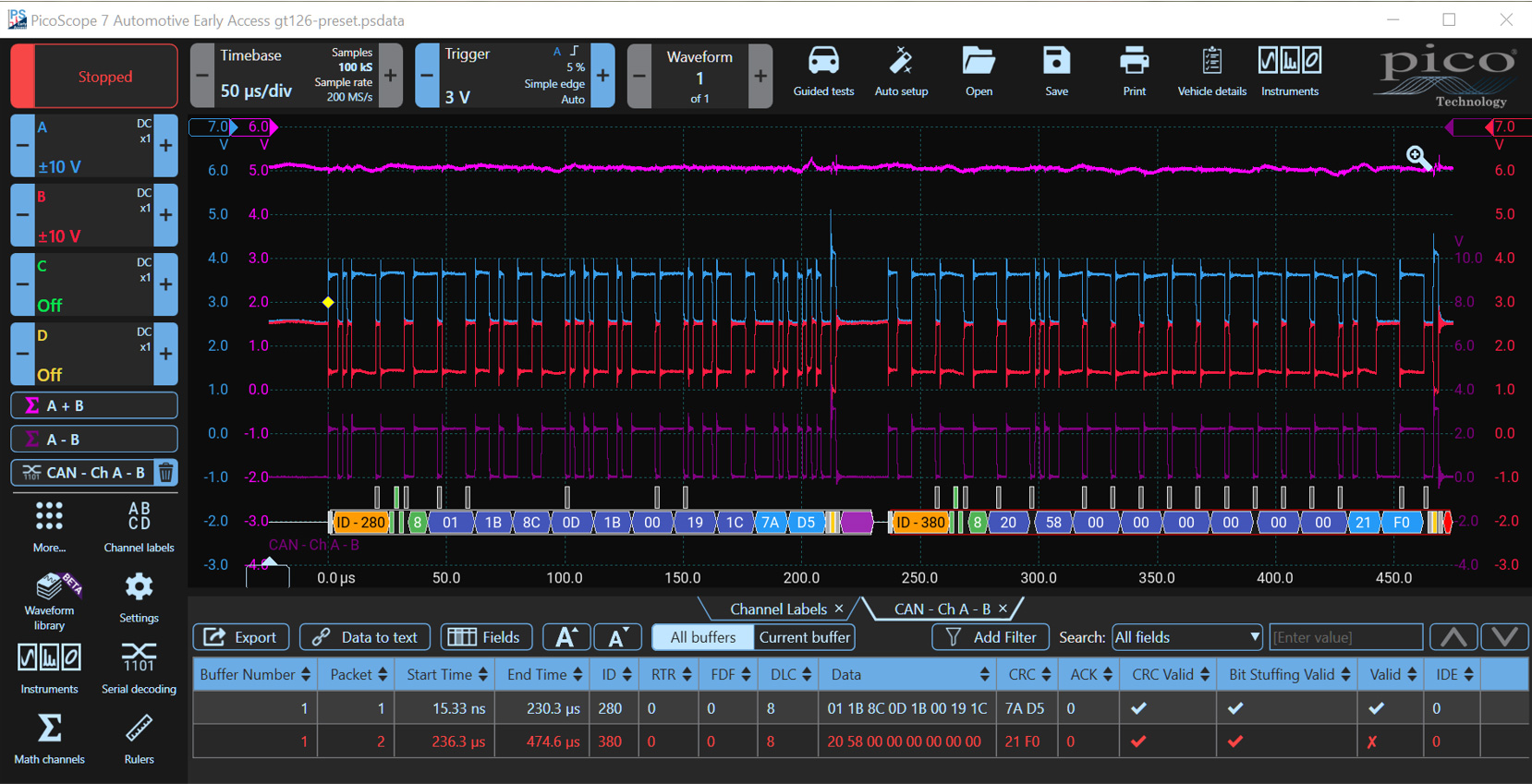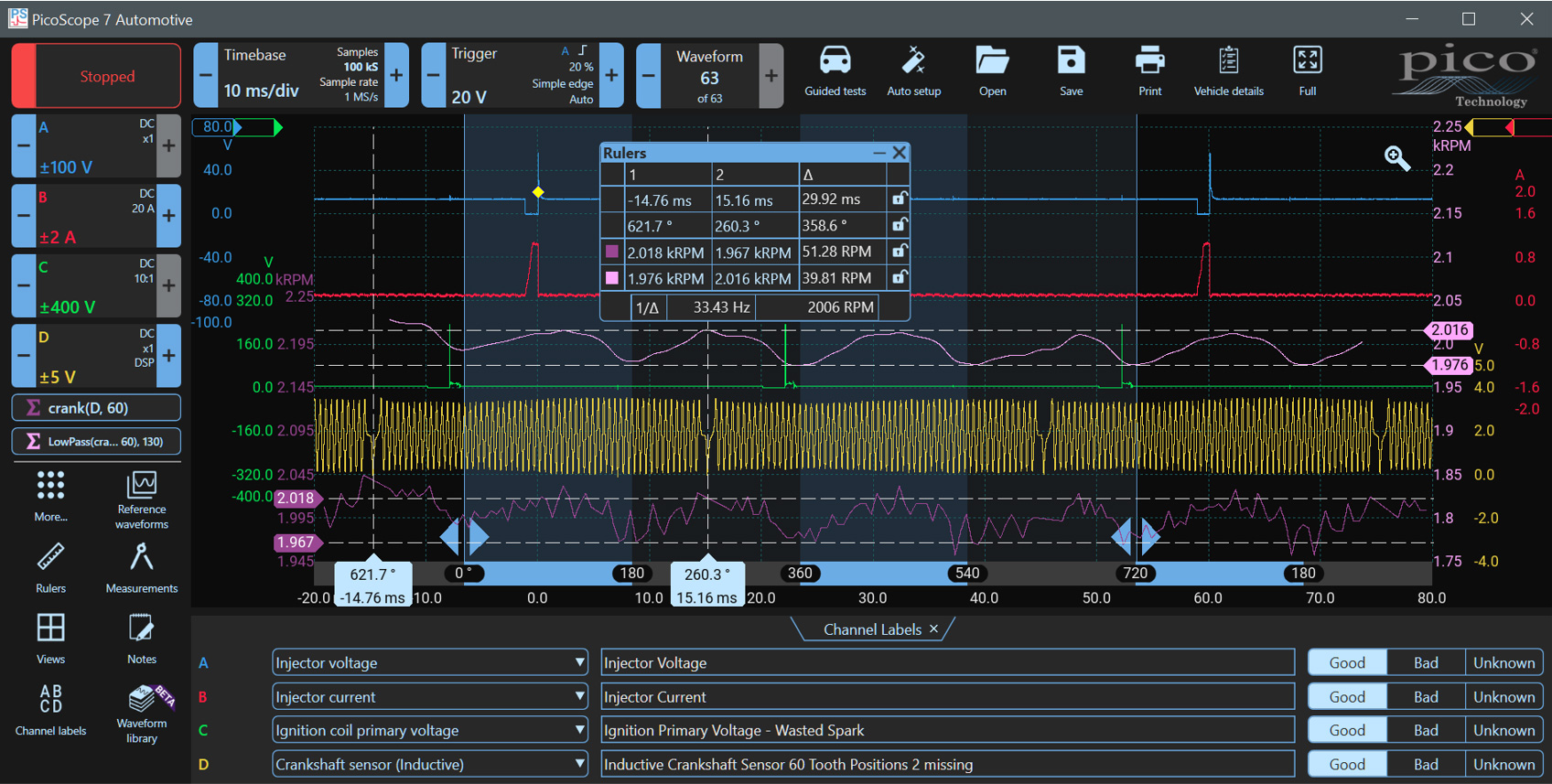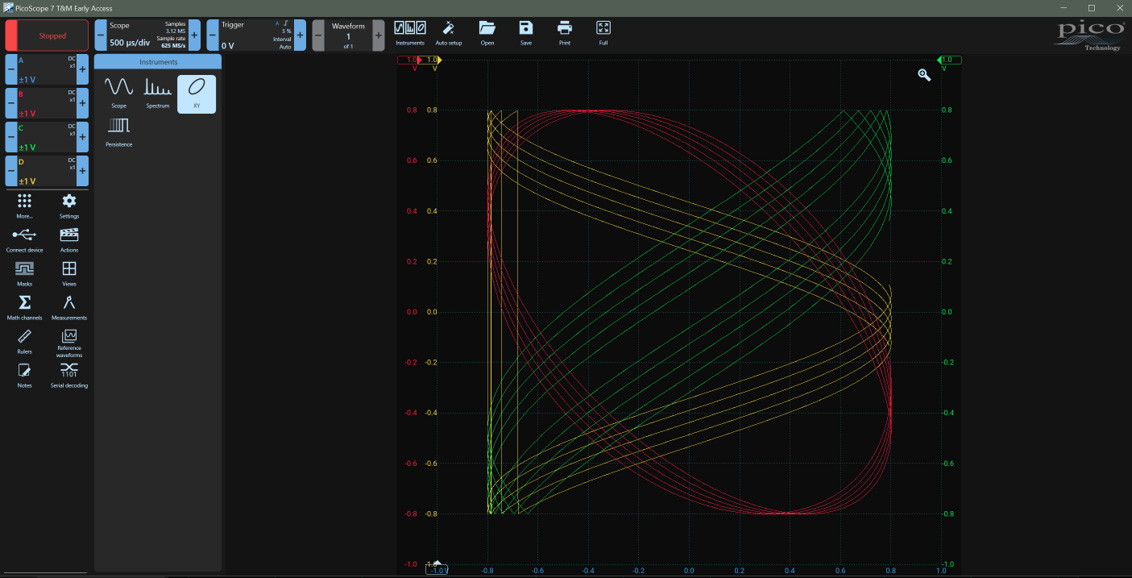PicoScope Automotive Advanced Features
For advanced users, the Automotive PicoScope offers a range of sophisticated features and capabilities that enhance its appeal to experienced professionals.
All the flexibility you need
PicoScope software is highly flexible and customisable, allowing advanced users to tailor the tool to their specific needs:

| R 18,339.00 ex VAT | R 2,750.85 VAT | R 21,089.85 inc VAT |

| R 29,337.00 ex VAT | R 4,400.55 VAT | R 33,737.55 inc VAT |

| R 52,305.00 ex VAT | R 7,845.75 VAT | R 60,150.75 inc VAT |
Advanced Triggers
A PicoScope's wide range of Advanced Triggers allows you to isolate and capture specific events within a complex signal, facilitating the diagnosis of intermittent faults or rare anomalies. This precision allows for efficient troubleshooting, focusing only on relevant data. It also reduces analysis time by filtering out unnecessary information thereby streamlining the diagnostic process.
Vertical Resolution
High vertical resolution (12 bits or 4,096 steps) enhances the ability to distinguish fine details in a signal, which is crucial for identifying small but significant electrical changes. For advanced diagnostics, this means more accurate detection of subtle faults or variations in sensor and actuator signals. It provides clearer insights into the health and performance of automotive systems.
Custom Probes
Custom probes allow you to tailor the oscilloscope's input to match specific diagnostic needs, ensuring accurate signal measurement and analysis. This flexibility is necessary when dealing with diverse automotive systems, such as high-voltage ignition circuits or low-voltage sensor signals. Custom probes also allow for better signal integrity and safety when working with specialised or sensitive components.
High Sample Rate
A high sample rate, up to 400 million samples per second, on the two and four-channel scopes and up to 80 million samples per second, on the 8-channel scope, provides a detailed and accurate representation of fast-changing signals. This is essential for diagnosing high-speed automotive systems, such as communications (e.g. CAN, CAN-FD, and Flexray), ignition, or fuel injection, where precise timing is critical. It ensures that no rapid events or anomalies are overlooked.
Wide Bandwidth
Wide bandwidth (20 Mhz) allows PicoScope to capture a broader range of frequencies, making it suitable for diagnosing modern vehicles with high-speed communication systems and high-frequency signals. This is vital for analysing data bus signals like CAN, CAN-FD, or FlexRay and for investigating issues in complex electronic systems. It ensures comprehensive coverage of all potential diagnostic needs.
Zoom
PicoScope has a large buffer (250-million samples), and its 12-bit (4,096-step) vertical resolution means that you can zoom into a waveform repeatedly and still see details. The zoomed portions have been overlaid to demonstrate the extent of zoom possible.
Deep Memory
Deep memory allows you to capture and analyse long-duration signals without missing any details, even when investigating infrequent or intermittent issues. This capability is essential for diagnosing complex problems over extended periods. It also enables detailed post-capture analysis, ensuring no data is lost.
Advanced measurements
Advanced measurements provide automated analysis of signal parameters such as amplitude, frequency, and timing, offering you detailed insights into the performance of automotive components. These precise metrics help you to assess system health and identify deviations from normal operation, quickly. They also enhance the accuracy of diagnostics by providing quantifiable data for decision-making.
Reference Waveforms
Reference Waveforms enable you to compare live signal data with known good or faulty waveforms, quickly identifying deviations or anomalies. This comparison is invaluable for diagnosing complex issues, as it helps you to pinpoint specific faults or malfunctions in automotive systems. Additionally, it provides a reliable baseline for verifying repairs and ensuring system integrity.
Frequency Counting
This accurately measures the frequency of a signal, which is essential for diagnosing components like engine control systems and sensors. This capability helps you to verify the operation of frequency-dependent systems and detect irregularities. It ensures that components are operating within their specified frequency ranges, critical for system reliability.
Frequency counting can be achieved using Maths Channels; however, the two and four-channel scopes feature hardware frequency counting built into the scope channel.
Persistence
Persistence changes the colour of the waveform depending on the number of times it is overwritten. That means you can detect intermittent signals.
Masks and Actions
Masks and Actions provide a way to define acceptable signal limits and automate responses when those limits are exceeded. This feature allows you to identify out-of-spec signals and take corrective action, quickly, ensuring compliance with operational tolerances. It enhances efficiency by automating repetitive checks and reducing manual intervention.
Maths Channels
Maths Channels enable you to perform calculations on signal data, creating custom waveforms from existing data, such as deriving resistance from voltage and current. This feature allows deeper analysis by providing new perspectives on signal interactions and relationships. It also aids in diagnosing complex issues by simplifying the interpretation of multiple signals.
For example, Maths Channels can also emulate communications receivers. CAN receivers subtract the two CAN-signals to remove noise. You can also add CAN-signals to hide the data and focus on interference.
Serial Decoding
This simplifies the analysis of complex data communications by translating serial data protocols like CAN, LIN, or FlexRay into readable formats. This feature is crucial for diagnosing issues in modern vehicles' data networks, allowing you to pinpoint communication errors. It facilitates troubleshooting by making it easier to understand and interpret data exchanges.
In the following example, PicoScope Maths is used to add CAN-H and CAN-L to focus on interference and then to subtract the two CAN-signals to hide the interference and focus on the data. The PicoScope then decodes the subtracted CAN signal messages to provide a clear understanding of the data being transmitted. This shows how different features can be combined to provide a greater insight into the system being tested.
In the following example, engine timing is analysed. The PicoScope monitors Injector Voltage, Current, Ignition, and the Crank Sensor. The Maths Channel extracts the engine speed from the Crank Sensor Signal. That speed signal is filtered, providing a clearer indication of instantaneous engine speed, useful for detecting misfires or under-performing cylinders. Notice how Phase, Level, and Timing Rulers are used to measure the aspects of the engine's operation. The Phase Rulers are particularly useful as they differentiate the four engine strokes.
Demo Mode Course
Try our free Demo Mode Course (No PicoScope Required) to learn how to set up PicoScope to perform the engine timing analysis and CAN Signal decoding.
Resolution Enhancement
This improves the signal resolution beyond the oscilloscope's hardware limitations, at the expense of bandwidth, providing clearer and more detailed waveforms. Resolution Enhancement is particularly useful for identifying small signal changes and noise in critical diagnostic scenarios. It enhances the accuracy of measurements and diagnostics, ensuring more reliable conclusions.
Waveform Navigator
The Waveform Navigator enables you to scan through long recordings and locate specific events or points of interest, quickly. This tool is invaluable for analysing large datasets, helping to identify anomalies or recurring patterns efficiently. It saves time by streamlining the process of reviewing and interpreting complex waveforms.
XY Mode
XY Mode allows you to plot one signal against another. Channel A is plotted on the X-axis, and the other channels are plotted vertically.
Spectrum Analyser
PicoScope can analyse signals in the Frequency Domain and can display the Spectrum. The Spectrum Analyser provides a visual frequency content representation of a signal, which is useful for identifying harmonics, noise, and other frequency-related issues. Spectrum Analysis is particularly important for Noise Vibration and Harshness (NVH) Analysis.
Comprehensive reporting and documentation
Advanced users often need to produce detailed reports and documentation for their diagnostic work. PicoScope software has what you need:
- Generate reports including relevant diagnostic data and waveform captures.
- Export data in various formats (CSV, PDF, etc.) for further analysis or archiving.
- Add annotations directly to waveforms, making it easier to document findings and share insights with colleagues or customers.

